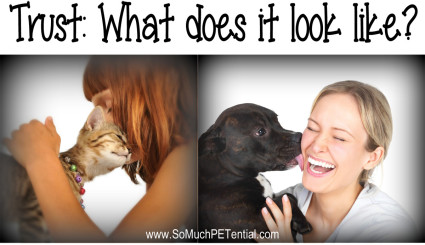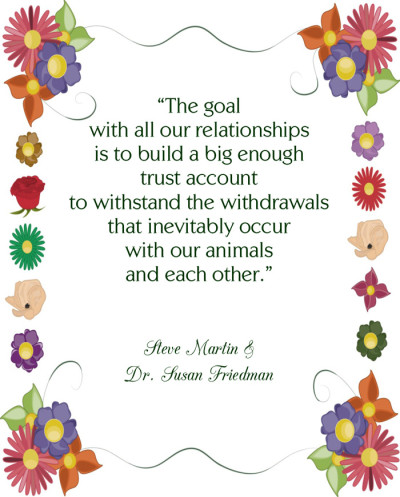I was rereading yesterday a 2103 IAATE Conference presentation made by Dr. Susan Friedman of Utah State University and Steve Martin of Natural Encounters.
The paper talks about a very important motivating operation (a change in the environment that temporarily increases the value of a behavior reinforcer) known as ‘trust’.
Hmm, what exactly does that mean? Well, let’s begin with a definition. According to the dictionary, ‘trust’ is defined as a confident expectation of something; hope; and a reliance on the integrity, strength, ability, surety of a person or thing.
As humans, we are much greater inclined to build relationships with others – either personal or for business – when trust is at its foundation. Between each other, we tend to share and empathize more. We are more open to others’ insight, and to compromise. We will work harder for those we trust. And more often than not, we tend to reciprocate trust with trust.
When you think about it, it makes perfect sense then that our non-human animals are also greater inclined to build relationships with and work harder for caregivers and teachers with whom trust is at the core foundation.
Let’s look at it from a behavior science perspective.
Susan and Steve wrote: “A useful way to operationalize trust is as a level of certainty that interaction will result in good outcomes and so interaction increases. Trusting animals use their behavior to confidently approach, rather than escape opportunities to interact with people. They not only accept invitations to interact with their trainers, trusting animals create interaction opportunities for their trainers as well.”
Think about this in action.
I had written years back about how my Chester (Alexandrine ringneck parakeet) would scream the minute my dad walked into the house and would retreat on his cage or fly from my shoulder if my dad were to walk into the room. However, a behavior modification plan involved reinforcing Chester for calm body language around my dad that ultimately resulted in my dad always entering the bird room with seeds in hand. (Please click here to read about my behavior change plan for them.) Soon, because my dad was always paired with valued seeds, Chester could reliably predict that interaction with him would result in good outcomes; and Chester began eliciting welcoming body language around my dad (wings slightly out and quivering, body leaning forward while shifting weight from left foot to right foot). Chester had learned to trust my dad.
Months back when I arrived for a first visit with a client whose dog would run away from new people, the sweet little guy was lying under a chair not wanting to come out. When he did venture out, I tossed some food away from me. He ate the food and I threw more food in another direction. Later I began teaching him that when he chose to do certain behaviors, treats would follow. I carefully watched his body language as an indicator of his stress. I was careful to make sure our interactions were very positive. When I arrived for the next visit, guess who was there at the door to greet me! Yep, he learned to trust me.
But what about the dog who returned to his owner when called (after a long delay) and was scolded when he got there? Do you think that dog would turn in an instant the next time his owner called him to come – if the dog was off leash and had the freedom to choose between coming or not coming?
Sure, as in any relationship, it is nearly impossible that every single interaction is going to have a positive outcome. This is life after all. Things happen. I may accidentally step on my dog’s foot or drop a loud object that scares my bird. I may inadvertently have my hand where it shouldn’t be, in front of a sick and stressed bird that may result in a bite.
“The goal with all our relationships,” Steve and Susan pointed out, “is to build a big enough trust account to withstand the withdrawals that inevitably occur with our animals and each other.”
Building the trust account
As your pet’s caregiver, day in and day out teachable moments happen all the time. Our animals are constantly learning from consequences which behaviors to practice and strengthen, or to reduce in frequency or extinguish. They are building their trust – or lack of trust – in us based upon their history of behavior outcomes associated with us.
Training dogs, parrots and other animals with positive reinforcement strategies is the greatest way to build that trust. When you can empower an animal by giving him control of his decisions, but just making the choices you would like him to make, the most valuable and easiest choices, you will see more of those wanted behaviors. And you will see an animal who solicits learning from you because learning is great.
How have you built your pet’s trust account? I’d love to hear from you.
Can I be of further help to you and your pet? Please contact me!








